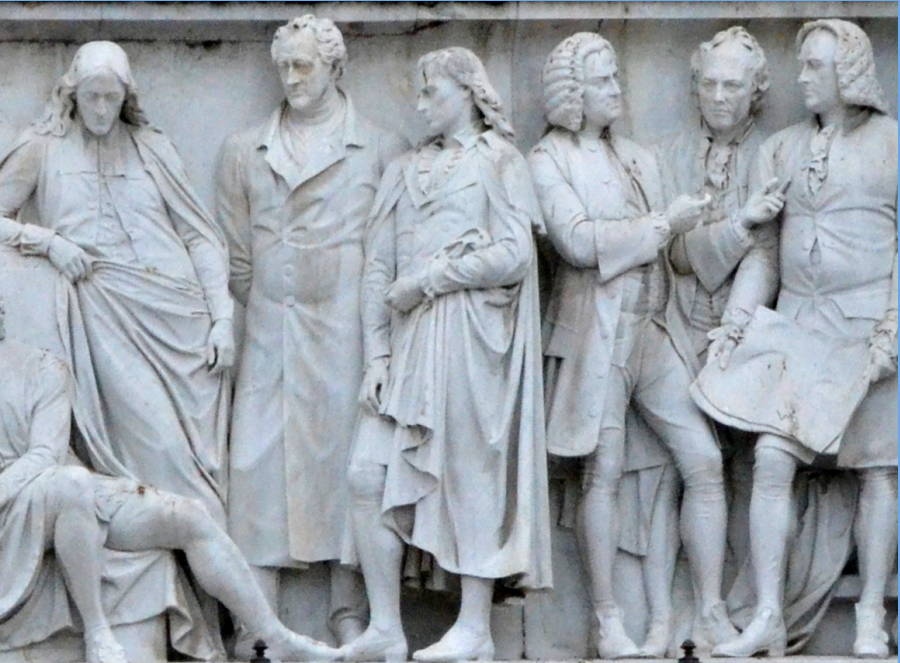
[Click on photographs to enlarge them.]
Commentary by John Lucas Tupper (1872)
In the centre is Homer enthroned, with the Phormynx resting on his left knee and grasped by the left hand: the shoulder of the harp is against his breast, and he touches the strings with a precision contrasting sharply with the vague "striking of the lyre” by "the bard" of ordinary sculpture. He has waited for the divine voice's utterance, and the plectrum goes instinctively to the right string. His listening, which simulates the listening of the blind, is not a hearkening to any sound, and the blind look is the blind look of inward thought. Dante, reclined on Homer's right, has turned, and is gazing up at him; he has suddenly upreared himself on rigid arms and flat-pressed hands, his left shoulder partly enfolded in Homer's mantle. There is the stress of mental absorption by which the limbs, traversed” by one nerve-force, are constrained to a rigid parallelism: the arms are two stark pillars, and the hands under them two plinths.

Contrast this rigid posture of mind and limb with the versatile flexibility of Shakespeare, who, seated, reclines on Homer's left. He is "hollowing one hand against his ear," like Tennyson's Numa. He is not looking at Homer, though, like Dante, he leans upon the throne of the divine Greek. His left hand keeps the place in his book, and, though the attitude is recumbent, you see those bent limbs are but momentarily bent, and that he will presently take some new vital posture; so instinct with free life is the whole frame, and so strikingly in contrast with the rigid austerity of Dante.
Immediately over Dante stands Virgil, leaning on one arm of the Homeric throne. He, as well as Dante, regards Homer, but the majestical composure of the regard is in signal contrast with the prostrate rapture of Dante. Why the sculptor has made Dante looking to Homer rather than to Virgil will, no doubt, be questioned; but when we remember that however Dante, in common with the poets of the revival, parades Virgil as his patron and guide, he really adopts very little of the suavity and repose of Virgil, there appears ample justification for representing both him and his avowed patron as looking, in a sort of theoretical fellowship, towards the common source of their inspiration. A little behind Virgil, and also leaning on the throne, is Pythagoras, a prophet, or poet in the old sense.
On the left hand, Chaucer rests on the throne, beard in palm, gazing Homerward with expatiating gaze. There is nothing of Homer-worship in his look: he worshipped the daisy quite as much. In front of him, and resting on the throne-arm, leans forward Milton, with a blind and pre-occupied down-drooping of the head, and unconsciously hanging arm and hand. He is the Milton of our spiritual, sedate, and even firm, but not austere, imaginings.

This group of the poets is completed” by Corneille, Moliere, and Cervantes, supporting Virgil on our left, and Schiller and Goethe supporting Milton on our right. Corneille leans away from the Homeric group somewhat abstractedly, while Moliere hugs to his heart the humour and pathos of actual life; and Cervantes askew looks over Virgil's shoulder, with a curious and somewhat infidel speculation about the solemn pomps of ancient poetry.

On the opposite side, next to Milton, stands the tower-like Goethe — Schiller next him in a muse.
The standing figures leaning on the throne are so arranged that their heads (without any apparent improbability) conspire, with the heads of Dante and Shakespeare, to form a ring as it were encircling Homer, while the erect; supporting figures add strength and solidity to the group. Moreover, a very forcible effect is obtained by this subtle arrangement. In the first place, the eye is impressed by, as it were, a sort of homage circling about the central point; and, secondly, we are sympathetically led to feel this” by observing how the more remote supporting groups are from each side regardful of this circle.
Photographs, text, and formatting by George P. Landow. [You may use these images without prior permission for any scholarly or educational purpose as long as you (1) credit the photographer and (2) link your document to this URL in a web document or cite the Victorian Web in a print one.]
Bibliography
Tupper, J. L. “Henry Hugh Armstead,” English Artists of the Present Day. Essays” by J. Beavington Atkinson, Sidney Colvin, F. G. Stephens, Tom Taylor, and John L. Tupper. London: Seeley, Jackson, and Halliday, 1872, 61-66.
Pevsner, Nikolaus. Berkshire. London: Penguin, 1988.
Content last modified 12 November 2011
Reformatted 16 March 2015